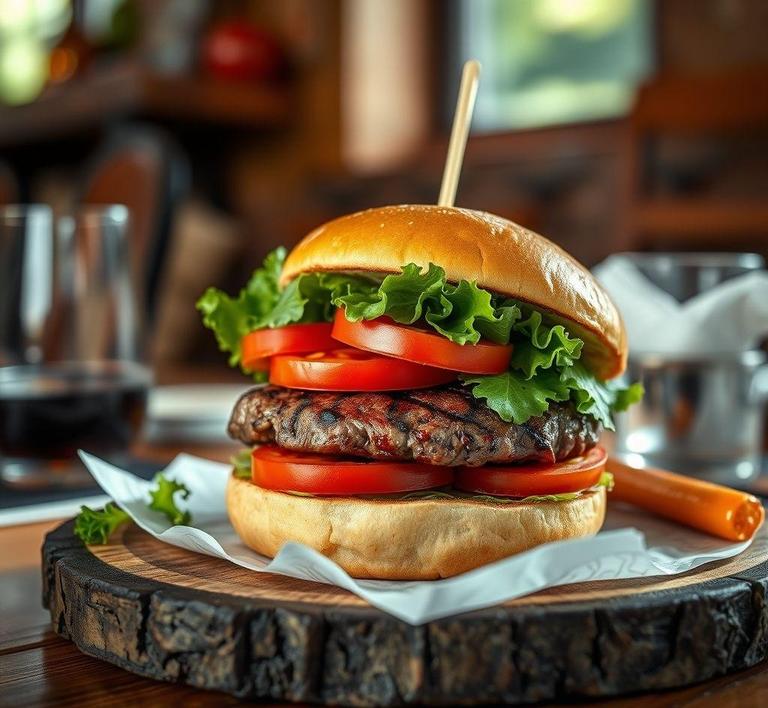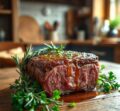Refreezing deer burgers is a handy skill for anyone who enjoys hunting or cooking with wild game. Whether you’ve made a large batch of delicious venison burgers or simply didn’t finish them all in one sitting, knowing how to properly refreeze deer burgers can help preserve their flavor and texture. With the right steps, you can maintain the quality of your burgers, ensuring they taste just as fresh when you’re ready to enjoy them again. This guide will walk you through the best methods for safely and effectively refreezing deer burgers, so you can enjoy your venison creations without any waste or loss in taste.
Can You Refreeze Deer Burger?

Yes, you can refreeze deer burger-but with some essential caveats. The possibility of safely refreezing venison largely depends on how the meat was handled during the initial thawing process. If the deer burger was thawed in the refrigerator and kept at or below 40°F (4°C) throughout, it is generally safe to refreeze. However, if it was thawed at room temperature, such as on a countertop, or if it sat in the refrigerator for several days after thawing, refreezing it may pose a risk of bacterial growth and subsequent foodborne illness.
It’s also critical to understand that while refreezing is physically possible, it doesn’t come without consequences. The safety aspect hinges entirely on temperature control, time out of refrigeration, and whether the meat shows any signs of spoilage-such as a sour smell, slimy texture, or discoloration. If in doubt, err on the side of caution and discard the questionable meat.
How To Refreeze Deer Burger?
If your deer burger passes the safety checks and you’ve decided to refreeze it, here are the best practices to preserve quality and ensure food safety:
-
Drain Excess Moisture:
After thawing, some liquid may have accumulated in the packaging. Gently drain or blot any excess moisture using a paper towel. This helps reduce ice crystal formation, which can degrade the texture of the meat.
-
Repackage Properly:
Use airtight, freezer-safe packaging to prevent freezer burn. Vacuum sealing is ideal, but if unavailable, wrap the meat tightly in plastic wrap or aluminum foil, then place it inside a heavy-duty freezer bag. Label the packaging with the date for reference.
-
Work Quickly:
Do not leave the deer burger at room temperature while preparing it for refreezing. Move efficiently from fridge to packaging to freezer to keep the meat within the safe temperature range.
-
Use Within a Short Timeframe:
Once deer burger has been refrozen, it’s best to use it within 1-2 months to ensure the best taste and texture. Although it can remain frozen longer, the quality will begin to diminish over time.
Quality Impact
Refreezing any meat-including deer burger-has a noticeable impact on quality, especially in terms of texture and flavor. When meat is frozen, ice crystals form within its cellular structure. These crystals can puncture and rupture muscle fibers. Upon thawing, the damaged fibers release moisture, resulting in a drier, more crumbly texture.
With venison, which is naturally lean, this effect can be even more pronounced. Unlike fattier meats such as ground beef, deer burger lacks the natural fat cushion that helps retain moisture and mouthfeel. As a result, refrozen venison can become tougher, more granular, and less juicy when cooked. The flavor may also be slightly altered due to repeated freezing and thawing cycles, which can cause oxidation and loss of subtle gamey notes that fresh venison is prized for.
That said, the impact on quality can be mitigated to some extent by using the refrozen burger in dishes where texture is less critical-such as chili, taco filling, meat sauces, or casseroles. These preparations can help reintroduce moisture and blend flavors in a way that masks the effects of refreezing.
Refreezing deer burger is both possible and safe-provided the initial thaw was handled properly. As a rule of thumb, never refreeze deer meat that was thawed outside the refrigerator or kept above 40°F for more than two hours. For optimal safety and quality, refreeze promptly in airtight packaging and consume within a couple of months.
While refreezing does affect the texture and potentially the flavor of venison, it doesn’t render it inedible or unsafe. When used in the right recipes and handled with care, refrozen deer burger can still provide a flavorful and satisfying meal. Ultimately, good judgment, safe food practices, and a creative approach in the kitchen will help you make the most of every pound of your harvested venison.
Is It Safe To Refreeze Deer Burger?
Refreezing deer burger, or ground venison, is generally safe-but only under specific conditions. The safety of refreezing primarily depends on how the meat was handled after it was initially thawed. If the venison was thawed in the refrigerator and kept below 40°F (4°C) at all times, then refreezing it is typically safe. However, this doesn’t mean the meat will retain its original quality.
When venison is frozen and thawed, the structure of the muscle fibers begins to degrade slightly, causing some loss of moisture and tenderness. Refreezing can exacerbate this texture loss and may dull the flavor slightly. While it won’t necessarily make the meat unsafe, it can make it less desirable from a culinary standpoint.
You should never refreeze deer burger that was thawed on the countertop or exposed to temperatures above 40°F for more than 2 hours. At that point, bacteria such as Salmonella and E. coli can multiply rapidly, even if the meat doesn’t look or smell spoiled. Freezing does not kill these bacteria-it merely halts their activity. So if the meat was compromised before refreezing, it will still pose a health risk once thawed again.
Signs That Deer Burger Should Not Be Refrozen
Knowing when deer burger is no longer safe to refreeze requires a combination of careful observation and awareness of its storage history. Here are the key signs to look for:
- Off Smell: A sour, ammonia-like, or rotten odor is a major red flag. Fresh deer burger should have a mild, meaty aroma, not a pungent or unpleasant scent.
- Discoloration: Venison typically has a rich reddish-purple hue. If it turns gray, green, or develops dark patches, it’s a sign of oxidation or bacterial growth-both of which indicate spoilage.
- Slimy or Sticky Texture: A tacky surface film on the meat suggests bacterial activity. Fresh ground venison should be moist but not slimy.
- Time at Room Temperature: If the burger was left out for more than 2 hours at room temperature-or 1 hour in hot conditions-it should not be refrozen or consumed.
- Questionable Thawing Methods: If the meat was thawed in warm water or a microwave and not cooked immediately, its safety for refreezing is compromised.
Common Refreezing Mistakes
Even seasoned hunters and cooks can make mistakes when it comes to refreezing deer burger. Understanding and avoiding these pitfalls can protect both the flavor of your meat and the health of those who consume it.
-
Refreezing After Partial Thawing at Room Temperature
Many people assume that if the meat is only slightly thawed, it’s fine to refreeze. However, if even the outer layer has warmed above 40°F, bacteria may have started to grow. Never base your decision solely on the firmness of the meat-temperature history is key.
-
Using Inadequate Packaging
Freezer burn occurs when air reaches the surface of the food, drying it out. Poorly wrapped venison can develop dry, grayish patches and off flavors. Always use airtight, vacuum-sealed bags or heavy-duty freezer paper to minimize air exposure.
-
Delaying Freezing After Thawing
If you thaw deer burger but don’t cook or refreeze it quickly (within 1-2 days of refrigeration), you risk bacterial growth. Time is of the essence once meat begins to thaw.
-
Refreezing Too Many Times
Each freeze-thaw cycle degrades the structure and quality of the meat. Aim to refreeze only once. Beyond that, the venison becomes increasingly dry, spongy, and less palatable.
Tips And Tricks
To make the most of your deer burger and ensure safety when refreezing, follow these expert tips:
- Label Everything: Always date your packages when freezing and refreezing. This allows you to track how long the meat has been stored and helps with meal planning.
- Portion Wisely: Freeze venison in meal-sized portions to reduce the need to thaw and refreeze large amounts. This also speeds up thawing and reduces food waste.
- Vacuum Seal: Invest in a vacuum sealer. It removes air, prevents freezer burn, and extends shelf life. If vacuum sealing isn’t an option, use a zip-top freezer bag and press out as much air as possible.
- Rapid Freeze: Place meat in the coldest part of your freezer to ensure it freezes quickly. Rapid freezing preserves texture and flavor better than a slow freeze.
- Use Cold Water Thawing Safely: If you need to thaw quickly, place the bagged meat in cold water and change the water every 30 minutes. Cook immediately afterward-do not refreeze unless it was kept cold the entire time.
Conclusion
Refreezing deer burger can be a safe and practical choice if done under the right conditions. The key lies in how the meat was thawed, how long it’s been out, and how well it’s been handled during the process. While quality may suffer slightly with each freeze-thaw cycle, safety doesn’t have to-so long as proper food handling guidelines are strictly followed.
By understanding the signs of spoilage, avoiding common refreezing mistakes, and following proven tips for storage and thawing, you can confidently preserve your hard-earned venison without compromising your health or your palate. Whether you’re stocking your freezer after a successful hunt or managing your meat supply efficiently, these best practices will help you savor every bite safely.


